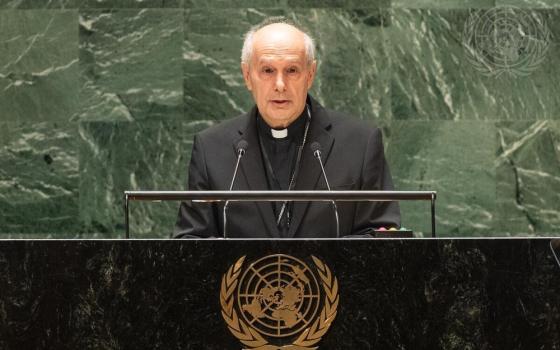Religion News Service
FINGERPRINTS OF GOD: THE SEARCH FOR THE SCIENCE OF SPIRITUALITY
By Barbara Bradley Hagerty
Published by Riverhead Hardcover, $26.95
For more than a year, Barbara Bradley Hagerty was a sleuth on God’s trail, hunting for evidence of the divine as far afield as a Native American tepee, brain scans, and epilepsy clinics.
As chronicled in her new book, Fingerprints of God: The Search for the Science of Spirituality, the award-winning National Public Radio correspondent donned a high-tech “God helmet,” parsed the human genome, and interrogated religious mystics -- all in an attempt to satisfy a hunch that there’s more to life than meets the eye.
But rather than lure her to some strange new world, Bradley Hagerty’s odyssey -- equal parts scientific quest and religious pilgrimage -- circled back to her spiritual birthplace: the Christian Science she had once practiced, but left during her 30s.
“It’s kind of nice to have a homecoming,” she said in a recent interview. Though she has not rejoined Christian Science, after poring over studies showing the power of mind over matter -- an idea long-held by Christian Scientists -- she has a renewed appreciation of the faith.
“I realized that Mary Baker Eddy was on to something, this mind-body connection, way before scientists were,” Bradley Hagerty said, referring to the founder of Christian Science. “Science is confirming some of these ideas that Christian Science avows.”
Likewise, the Christian Science conception of God -- more cosmic ideal than grey-bearded grandfather -- now seemed more plausible. “Without realizing it at first,” she writes in God’s Fingerprints, “I had looped back to the faith of my childhood. I found myself staring squarely at Mary Baker Eddy’s definition of God: `Principle; Mind; Soul; Spirit ... Truth; Love.”
Fifteen years ago, on a snowy morning in New Haven, Conn., Bradley Hagerty’s break with Christian Science came in the form of a little yellow pill. Suffering from a stomach flu, with a fever and chills wracking her body, she succumbed to modern medicine and took a Tylenol.
As a Christian Scientist for more than 30 years, Bradley Hagerty had turned to prayer for everything from headaches to heartaches to job concerns. As Baker Eddy taught, physical problems are just a manifestation of spiritual problems: to heal the body, you must heal the spirit. Bradley Hagerty had witnessed the efficacy of such methods among friends and family.
But all that praying was “tough sledding,” as she puts it. And popping a Tylenol was so simple. A half hour later, she was out of bed for the first time in two days and making tomato soup. “After that, I thought, `Why would I forgo modern medicine?”‘ Bradley Hagerty said.
Still, it was a wrenching experience to leave the fold of her faith. “Everything that I cared about deeply -- my relationship with my parents, my friends at church, my job at The Christian Science Monitor, the metaphysical worldview that steered my thoughts and actions -- all of this threatened to topple once I admitted that I no longer had the energy or fortitude to believe in Christian Science,” Bradley Hagerty writes.
She held fast to her idea of God, however; and, after experiencing a mystical moment while interviewing a woman in California, Bradley Hagerty resolved to use her training as a journalist to investigate what science can tell us about such experiences.
It was a daunting task. Bradley Hagerty had little training in science, and she risked criticism from colleagues for making her own faith part of the story. Even more frightening: What if she discovered her faith was folly, nothing more than a few brain waves?
“Basically, it was the hardest test I could put spirituality to,” Bradley Hagerty said. “If you can take a group of people and allow them to use their tools to try to debunk spiritual experience and they can’t, and you even see circumstantial evidence (supporting it) -- that’s a big deal.”
So, all in the name of science, Bradley Hagerty lay in a brain scanner while a minister prayed for her. She sat cross-legged in tepee for eight hours during a Native American peyote ceremony. She found a non-religious man who became a devout Buddhist after developing temporal lobe epilepsy, a woman who seemed to float above her body while doctors were performing major brain surgery, and identical twins separated at birth who became equally pious -- one Christian, the other Jewish.
She read scientific studies about the effects of Buddhist meditation and bravely donned an electrode-fitted motorcycle helmet meant to evoke mystical experiences on the wearer. She interviewed geneticists, mystics, psychologists, psychiatrists, neurologists, bioethicists, Sufis, Buddhists, Christians, shamans, and atheists.
In the end, Bradley Hagerty said, it comes down to how you read the evidence. Hardcore atheists can look at the body and see a closed system of cells and electrical currents. Believers see an elaborate circuitry meant for something beyond remembering birthdays and shopping lists: it’s hard-wired to connect with God.
Wherever the science takes us, Bradley Hagerty said she’s happy where it led her -- closer to her Christian Science friends and family.
“It was an unexpected benefit for kind of a personal reason,” she said. “I’m extremely close with my mom ... and I could talk to her about all of these issues and she understood them in many ways better than my other religious friends.”



